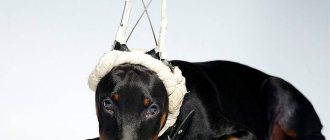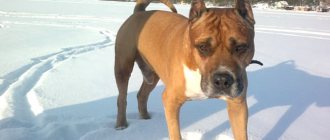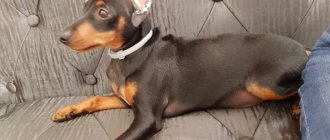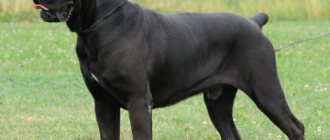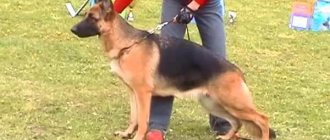The Toy Terrier is one of the smallest dog breeds, arousing everyone's admiration.
The most striking feature of the breed is its large, erect and high-set ears.
The toy terrier is smaller in size than a large domestic cat, it has a compact build and a cheerful disposition.
In addition, the dog is incredibly active, and such a pet does not require complex care.
The life expectancy of such a pet is 12-15 years, weight 1-3 kg, height at the withers 25-30 cm. The breed is predisposed to some diseases, however, it has relatively good health.
What kind of tail should that terrier have?
COUNTRY OF ORIGIN: Russia.
PUBLICATION DATE OF THE ORIGINAL OF THE VALID STANDARD: 07.11.2017
APPLICATION: Dog – companion.
Section 9. Continental Toy Spaniels and Russian Toy.
No operational tests.
GENERAL APPEARANCE: A small, elegant, high-legged dog with fine bones and lean muscles. Very harmonious and proportional. The sexual type is weakly expressed.
IMPORTANT PROPORTIONS: - The length of the body is equal to the height of the dog at the withers. — The height at the elbow is slightly more than half the height at the withers. - The chest reaches the level of the elbows. — The muzzle is shorter than the skull.
BEHAVIOR/TEMPERAMENT: Active, very cheerful, not cowardly or angry. Always interested in the world, strong attachment to the owner.
HEAD: Small in relation to the body. Light, dry, wedge-shaped when viewed from above. Without a clearly prominent occipital protuberance.
Skull: High, but not too wide (the width at the cheekbones does not exceed the height of the skull), with a somewhat rounded forehead. The roundness should be well defined, but not exaggerated.
Transition from forehead to muzzle: Well defined, of medium depth.
Nose: Small, well developed, nostrils well opened. Black or matching color.
Muzzle: Dry, moderately pointed, gradually tapering towards the nose. Shorter in length than the skull: from 1/3 to 2/5 of the length of the head. The bridge of the nose is straight.
Lips: Thin, dry, tightly fitting, dark or matching color.
Jaws/Teeth: Scissor bite. A straight bite extending over 2-3 pairs of incisors is acceptable, but undesirable. The teeth are white and medium in size.
Cheekbones: Flat, poorly defined.
Eyes: Quite large, round, expressive, set wide and straight. As dark as possible. The eyelids are dark or to match the color, tightly fitting. The look is interested, smart, friendly, meaningful.
Ears: Large, thin, set high, erect, in the shape of a high isosceles triangle. The long-haired variety may have slightly floppy hair.
NECK: Long, dry, set high.
Topline: Slopes smoothly from the withers to the base of the tail.
Withers: Slightly pronounced.
Loin: Short, fairly muscular, slightly arched.
Chest: Reaches to the level of the elbows, in cross section in the shape of a slightly flattened oval.
Underline: Belly tucked, groins tucked in, underline beautifully curved.
TAIL: Medium length, saber- or crescent-shaped, without bends or thickenings. Moderately high set. It is advisable that when moving the tail does not fall below the level of the back, but also does not lie on the back. A docked tail is acceptable, leaving 2-4 vertebrae.
GENERAL APPEARANCE: When viewed from the front, parallel. When viewed from the side, the forearms are located under the body. The height at the elbow is slightly more than half the height at the withers.
Shoulders: Moderate length, moderately sloped.
Shoulders: Approximately equal in length to the shoulder blades. The angle of the shoulder-scapular joints is 100-110 degrees.
Elbows: Directed straight back.
Forearms: Long, straight.
Forefeet: Small, oval, toes tightly gathered in a ball, directed forward, claws black or matching color, elastic pads, black or matching color.
GENERAL APPEARANCE: When viewed from behind, straight and parallel, set slightly wider than the front ones. The angles of the stifles and hocks are moderately pronounced and are in balance with the angulations of the forelimbs. When viewed from the side, they are slightly set back.
Thighs: Moderate length, dry and well muscled.
Lower legs: Approximately equal in length to thighs.
Hocks: Moderately angulated.
Hocks: Set vertically, parallel to each other.
Hind feet: slightly narrower than the front feet, toes tightly gathered into a ball, directed forward, claws and pads black or matching color.
GAIT/MOVEMENT: Movement is free, straight, light, energetic, moderately sweeping. At the trot, a level topline is maintained, above which the withers rise slightly. When moving, the dog holds its head proudly and carries its tail quite high.
SKIN: Thin, tightly fitting to the body.
COAT: There are two varieties: smooth and longhaired.
* Smooth: the coat is short, close-lying, shiny, without undercoat or bald patches. * Long-haired: the body and neck are covered with moderately long (3 – 5 cm) straight or slightly wavy, close-lying hair. The hair on the head and front sides of the legs is short and close-lying. The back sides of the limbs and the tail are covered with developed decorative hair. The ears are covered with thick and long hair in the form of a fringe. In adult dogs, the fringe should completely cover the outer edges and tips of the ears. The fur on the body should not be tousled or plump.
COLOR: Black and tan, brown and tan, blue and tan, lilac and tan, red and black, red and blue, red, fawn, red and brown, red and lilac, cream. Nose to match color
WEIGHT: Males and females: up to 3 kg.
Most desirable: height 25 cm, weight 2.3 kg.
Any deviation from the above points shall be regarded as a defect. The seriousness of the defect should be proportional to its degree.
* Timid behavior. * Height less than 22 cm and more than 27 cm. * Stretched format, excessively convex lower back, sloping croup. * Absence of 1 or 2 incisors in the upper and/or lower jaw. * Semi-erect ears in the long-haired variety, unless this is caused by heavy hair. * Soft ears on the smooth-haired variety. * Weak lower jaw. * A narrow or heavy muzzle, as well as an upturned or downturned muzzle. * Turned elbows, markings. *Excessively straightened angles of the front and rear legs. * Excessively pronounced angles of the hind legs. * Low set tail, tail in a ring, spiral or lying on the back. * Slight baldness in the smooth-haired variety. * Excessively long, loose or slightly wavy hair on the body in the long-haired variety, tousled or puffy hair, lack of decorative hair on the tail. * Small white markings on chest and toes. * Excessively wide or blurred, as well as widespread or darkened markings.
DISQUALIFYING VICES: * Aggression or cowardice. * Any dog clearly exhibiting physical or behavioral abnormalities must be disqualified. * Overshot, straight bite on all incisors, underbite, jaw misalignment, absence of any canine or more than 2 incisors in any jaw. * The canines of the lower jaw rest against the gum or palate of the upper jaw. * Constantly visible tongue when mouth is closed. * Presence of a fontanelle in dogs older than 9 months. * Short legs. * Excessively voluminous, massive chest. * Semi-erect ears in the smooth-haired variety. * Drop ears in the long-haired variety. * In smooth-haired dogs there are very large amounts of receding hair (more than 25%), very soft, tousled hair on the body that does not adhere to the skin, or excessively long hair with pronounced feathering on the limbs and tail, signs of clipping. * In long-haired dogs there is a lack of decorative hair on the ears, signs of hair clipping on the body, and curliness. Semi-erect ears without decorative fur. * Creases or thickening on the tail. * White spots on the head, throat, on the limbs above the pasterns/tarsus, large white spots on the chest, the presence of brindle, as well as any color not specified in the standard. * Height more than 29 or less than 18 cm, weight more than 3 kg or less than 1.5 kg.
Note: Males must have two normal testes fully descended into the scrotum. Only functionally and clinically healthy dogs with pedigree conformation can be used for breeding
Source
Docking a toy terrier's tail.
The standard requiring docking of the toy terrier's tail causes many denials from veterinarians. Many dog breeders and simply lovers of four-legged friends also have a negative attitude towards this issue. After all, if we consider the standard of the English Toy Terrier, then the presence of a tip is mandatory. But in the smooth-haired miniature toy and the Russian longhaired toy terrier, the tip must be docked. Although, some exhibitions (especially abroad) are already accepting dogs with appendages and giving high marks. So, as you can see, there is no consensus on this matter.
Cupping itself eliminates one single problem - creases in the extremity. But at the same time, a toy terrier without a tail becomes, as it were, a “goal” in the rings, since the luxurious flag appendage (like the Russian toy terriers) hides the shortcomings visible in standard “samples” of the decorative breed. The docking allows you to carefully examine the dog's croup and, if present, identify the elongation of the body and short legs. The judges' focus shifts to the shortcomings or lack thereof of your pet. And if your pet’s body has ideal proportions, then the cut off tip will only emphasize the beauty of the miniature dog.
Are there any indications?
Docking is done to avoid the creases that often accompany this breed. A long tail is also allowed by the exterior, but it must be curled into a sickle. If the species is different, the dog is no longer considered purebred. She is prohibited from participating in exhibitions and breeding.
Medical indications for tail docking in toys are rare. Surgery is only performed if the dog has had a serious injury, such as a fracture, and the animal cannot recover.
A long tail hides exterior flaws in the rear of the body, while a short tail exposes them. If your pet has imperfections that can be covered with a tail, it is better to leave it so as not to displease the judges at shows.
Does a Toy Terrier need to have its tail docked?
The answer to the question “Why do terriers have their tails docked?” lies in the breed standard. The requirements for a decorative dog state that the tail must be docked short, but an undocked tail is also permitted. Docked means that the animal is left with two or three tail vertebrae. Undocked – should be (preferably) sickle shaped and carried above the dorsal line. In case you were wondering, show judging determines the standard of an undocked toy terrier based on how the tip comes out when the croup is sloping. So, it should be where the hour hand is on the dial - in the interval from “half past twelve” to “half past two”. The need to hold an undocked appendage during a stationary trot can harm the dog's movements.
But! Let's once again divide our miniature toys into smooth-haired and long-haired, and talk about the Russian toy terrier. The long-haired dog has won the hearts of foreign dog breeders to such an extent that it was for this particular variety that they even began to prohibit docking the tails of terriers with beautiful fur. And our breeders, knowing the love of respected judges for tailed beauties and beauties, believe that there is no need to cut off the tails of terriers with long hair. As you can see, opinions differ.
When toy terriers have their tails docked.
You have decided to dock the puppy's tail, and are wondering when is the best time to dock the tail of the toy terrier. If you listen to the opinion of veterinarians about what day the tails of toy terriers are docked, it turns out that cutting off the tip literally after the birth of small dogs would be ideal. The first week after birth seems to be meant for this. The fact is that a newborn puppy does not experience pain during the circumcision procedure, since the nerve endings are just beginning to form. Yes, the puppy will squeak when docked, but this is more likely a reflexive reaction to the head-down position (circumcision is carried out by lifting the puppy and turning it upside down).
You can carry out the docking procedure yourself in the first week of a dog’s life. But if the puppy is older than a week, then entrust the cutting off of the end to a professional - a dog doctor. Only a specialist will correctly carry out the procedure, process and professionally sew up the docked tail of a toy terrier.
You can cut off a small appendage yourself by using one of two existing methods - circumcision and using an elastic band. Whatever docking method you choose, be sure to remove the puppies’ mother from the premises before performing this procedure.
The most important thing is to clearly measure the number of vertebrae that should be left. This is not entirely easy to do, but it is possible.
To shorten the tip using trimming, prepare the following items:
Disinfect scissors by either boiling them or wiping them with medical alcohol. Also treat your hands with alcohol. Take someone from your household (not children) or acquaintances as your assistant. The assistant will hold the puppies in his hands.
Having placed the puppy on the table, feel the required length of the tip, straightening the skin on the tail from the base to the very tip. With two fingers (thumb and forefinger), firmly hold the tip, and with a sharp movement, cut the tail with scissors. Then turn the baby over with his tummy up and treat the wound with alcohol and manganese crystals. Calm the puppy and observe him for a few minutes. The bleeding has stopped - send the puppy to an enclosure or playpen. If the blood continues to flow, then tightly pull the tip with a thread, which must be removed after two hours.
When cupping with an elastic band, gather the skin of the tip towards the base. And then wrap the elastic band around the desired spine and tie it in a tight knot. The baby spends about three days with this device, after which the dead part will fall off on its own. If you have clamped the elastic incorrectly, you can move it to another place at any time. It should be noted that this method is the most humane.
Don’t let the dog lick the tip too much, then in about ten days everything will heal.
Source
Briefly about the operation
According to archival data, tail docking in dogs is a long-standing practice . Ancient peasants always cut off part of the tail of their shepherd dogs. They believed that such manipulation would protect the animal from diseases, in particular from rabies.
Hunting dogs had their tails cut off so that they could not be injured during a conflict with a predatory animal. This measure also made it possible to avoid injury from the underbrush while tracking a prey while hunting. Dogs that are burrowers were amputated so that they would not interfere with the animal’s progress through the narrow burrow. Here the meaning of the intervention is clear and justified. But is this consideration the key motive for the operation?
In fact, the point of docking was not only to ensure the safety of the animal, but also financial issues . In ancient England, a special tax was introduced on any dogs other than service dogs. Since it is mandatory for service dogs to have their tails docked, the tax-exempt owner was immediately visible. In order to save money, operations began to be performed on other dogs.
In those ancient times, it was believed that an undocked tail could only belong to a hunting dog, so poachers, in order to avoid responsibility, also cut the tails of their pets and thereby “blurred their eyes.”
Owners of sheep flocks always docked the tails of their shepherd dogs to protect the animal from injury in the event of a fight with a wolf, and this also helped to avoid lengthy combing of the fur from grass and debris. Such owners of shepherd dogs also did not pay tax. In the 18th century, the dog tax law was repealed, but the tradition remained and the appearance of some dog breeds was fixed in this form - with a docked tail.
Today in Europe it is prohibited to perform this operation only for cosmetic purposes. Only service dogs that are in service in:
In 2006, a law was passed stating that only a qualified specialist must dock a dog no later than five days after the puppy is born.
Purpose
The tradition of docking dogs goes back to the times of Ancient Egypt. During archaeological excavations, frescoes and coins were discovered depicting dogs with cropped ears - these finds date back to the 5th century. BC e.
Cupping was also common in other countries. Thus, the famous traveler of that time, Pylos, in his chronicles, described the “barbaric custom” of the Romans - cutting off the tails and ears of dogs. The Romans believed that in this way they could protect their pets from rabies.
It is known that in the Middle Ages a tax was introduced on domestic dogs, the amount of which varied depending on the purpose and specialization of the animal. In order to distinguish how much a dog was valued at, their ears or tails were cut off, and it could also be both tails and ears.
At the end of the 90s of the last century, the “Convention on the Rights of Pet Animals” was adopted in Europe, which established a ban on cosmetic operations on dogs unless they are caused by medical necessity.
In Russia, this ban does not apply, so in our country the decision on docking remains at the discretion of the breeder.
Today, there is no consensus on the need to cut ears and tails among dog handlers - most of them are inclined to believe that this cruel operation is pointless. However, a fairly impressive group of experts argue that docking is part of a long-standing tradition that is designed to improve the appearance of the animal.
Where did the tradition of cutting off the tails and ears of dogs come from? In ancient times, dogs in most cases performed one or another duty - they guarded herds, guarded houses, protected their owner, or took part in fierce battles.
In the course of performing their functions, animals often found themselves injured, received bleeding lacerations, and it was the ears and tail that suffered more often than other parts of the dog’s body.
In order to avoid such injuries, people began to remove ears and part of the tail. Over the course of several centuries, this became such a habit that many began to consider this type of pet the norm.
Nowadays, dogs are mainly kept as companions, so docking is carried out at the request of the owner if he believes that in this way his four-legged friend will look more threatening, sharp and powerful.
In addition, there are a number of medical indications in which cupping becomes a necessary necessity, these include:
- lacerations and other mechanical damage;
- multiple inflammations and non-healing ulcers;
- necrosis of all types;
- burns;
- frostbite;
- malignant and benign neoplasms.
Like any surgical intervention, cupping has certain contraindications. In particular, circumcision is not performed on sick, weakened or recovering dogs. In addition, the reason for the ban may be the inappropriate return of a four-legged friend.
Cupping is carried out only in veterinary clinics, since all sterility requirements are met in the operating rooms, and the doctor has at hand all the tools necessary in case of unscheduled situations.
Intervention at home is allowed in exceptional cases and only by a professional veterinarian.
Keep in mind that the risk of complications after circumcision in a well-equipped hospital equipped with all the necessary medications is much lower than after a procedure performed in a homemade manner - the result of an intervention at home is quite difficult to predict.
What kind of tail should that terrier have?
From the breed standard Russian Toy Terrier
:
TAIL : Shortly docked (leaving 2-3 vertebrae), the dog carries it gaily upward.
An undocked tail is also acceptable, preferably crescent-shaped and carried no lower than the line of the back. Previously, according to the standard, a toy terrier had to have a docked tail. Currently, the Russian Toy breed is included in the international FCI system. In most foreign countries, participation in dog shows with docked tails is PROHIBITED. Therefore, Russian breeders who sell puppies to foreigners have stopped docking the tails of toy terriers. Russians also liked tailed Toys, so their tails are docked less and less often. In long-haired toy terriers
the tail is well dressed, often better than the ears and certainly adds charm to long-haired dogs. His ponytail suits the Russian Toy very well! It emphasizes the cheerful, cheerful disposition of our Russian breed, and how many emotions it can express with its tail cannot be described in words!!
Breed standard
The specific length of the tail is not specified in the breed's conformation. Usually only 2-3 vertebrae are left from the appendage. A toy terrier with a tail falls under other requirements. The appendage should be positioned in the shape of a sickle, but not cross the line of the back. If the dog participates in shows, it will be difficult for him to keep his tail in this position during a staged trot, which is why some owners decide to trim it.
The Toy Terrier is one of the smallest dog breeds, arousing everyone's admiration.
The most striking feature of the breed is its large, erect and high-set ears.
The toy terrier is smaller in size than a large domestic cat, it has a compact build and a cheerful disposition.
In addition, the dog is incredibly active, and such a pet does not require complex care.
The life expectancy of such a pet is 12-15 years, weight 1-3 kg, height at the withers 25-30 cm. The breed is predisposed to some diseases, however, it has relatively good health.
Age for tail docking in dogs
The ideal age for a puppy to undergo surgery is considered to be from three to 10 days old . This is the recommendation of all veterinarians in the country. Since in these few days complete ossification of the tail has not yet occurred and the pain during the operation is much less than if this operation is performed on an adult dog.
For small newborn puppies, docking is performed without the use of anesthesia and without stitches. But after the operation, the puppy's owner must be very careful that the baby's mother does not lick the wound, as this will prolong the healing period. If this does happen, then the baby must be isolated from the mother and brought in only at the time of feeding.
If the operation is performed after 10 days of the puppy’s life, it will be done under general anesthesia . The animal is placed on its stomach, its limbs are tied, and in this position it is very convenient for the doctor to perform any manipulations with the animal’s tail. The body is also secured with special straps, and a muzzle must be worn.
If the puppy is more than four weeks old, then during the operation a rubber tourniquet is applied to the tail, which prevents excessive bleeding.
Why is it not necessary to crop your ears?
Any attempt to change the shape of the Toy Terrier's ears is considered grounds for disqualifying the dog from the show.
Animals with cropped ears are not allowed to participate in the exhibition..
Tolkachev Andrey Mikhailovich
“I would like to debunk several myths about the benefits of ear cropping in toy terriers. Firstly, the information that dogs with cropped ears do not get otitis media is not true. Quite the contrary, cropped ears cannot protect the ear canal from infections and wind and parasites, and this is precisely what leads to otitis media. Even if your dog's ears do not want to go up, this is not a reason for such a procedure. Secondly, any dog that has undergone docking will experience pain and stress, regardless of age. Thirdly, the entire civilized world has practically moved away from such methods, since this is a useless and meaningless practice. In most European countries, docking is prohibited.”
Postoperative care
The owner must carefully monitor the dryness and cleanliness of the postoperative wound until it heals. Additional treatment is discussed with your veterinarian. Moisturizing ointments inhibit the regeneration process, so they are used only for their intended purpose.
If there are any signs of suppuration, contact your veterinarian immediately. Temporary separation from the mother will also be required. If she persistently licks the puppies' wounds, isolate her in a separate room and bring her to the pups only for feeding.
Description of methods for docking puppies
There is a claim that puppies do not feel pain because of their imperfect nervous system, but all kinds of studies refute this fact . After surgery, the puppy whines for a long time and cannot calm down. And the older the individual, the more difficult it is for her to endure this operation. Breeders must make a responsible decision and understand whether it is really worth putting their beloved pet through suffering.
The postoperative wound takes a long time to heal . And the entire period from the day of surgery until complete healing, the wound must be treated daily to prevent infection. When docking is performed in a specialized veterinary clinic, there are rarely cases of complications. Usually everything goes pretty smoothly.
Rehabilitation period
The puppies are experiencing recovery after surgery calmly. Within a few hours after the procedure, the toy terrier stops being nervous and becomes active again. If the veterinarian has placed stitches, they must be treated with an antiseptic daily. Your puppy's bedding needs to be changed regularly to prevent infection.
It is advisable to isolate the mother from the puppy, as she will lick his wound, which contributes to infection. If your pet has not been anesthetized, no dietary changes are required. Otherwise, it is necessary to give food little by little and first in semi-liquid form.
There may be some complications after surgery. Adult dogs often experience bleeding, lumps and scars at the site where the tail is cut. The bleeding is stopped with veterinary powder or a pencil, but the scars will remain for life. If the wound is inflamed, there is likely an infection. For treatment you need to go to the clinic.
Tail fracture
The operation is performed under general anesthesia and a suture is required. After 7-10 days, the suture is removed. During this week, it is advisable for the dog to wear a protective collar to prevent it from licking the seams. The wound usually heals very quickly.
You can leave the tip of the tail as is, it will not grow together very smoothly, it will look like a crease. But this does not stop the dog from living. Be sure to get a certificate from your veterinarian stating that the tail was indeed broken and is not a genetic defect. You can also attach an x-ray to the certificate. You will need these documents at the show to ensure your dog is not disqualified for having a broken tail.
www.toy-volgograd.ru Any copying of material requires a direct and active link to our website!
Effect of docking surgery on a dog
Opponents of tail amputation give many arguments against the docking process, but for many breeders the conformation of a purebred dog is very important and they still lead them to this procedure.
Whether the intensity of the dog’s pain somehow changes in the future has not been determined or proven by science. But there are a few “buts”:
There are no scientifically proven facts about these problems, but, be that as it may, amputation cannot pass without a trace for the dog . Before performing this operation on a pet, the owner needs to think carefully about why this is necessary. If only for aesthetic reasons, then it’s probably not worth docking your beloved dog.
Stages of the procedure
When performing an operation without anesthesia, it is better for the owner to hold the pet with his hands so that he does not escape, and the veterinarian carries out all the manipulations without errors. The procedure follows the following scheme:
The whole process lasts no more than 5 minutes. You can call a veterinarian to your home and carry out the procedure in more comfortable conditions for the dog, especially if it has already grown up. The operation scheme is no different from the clinic conditions.
It is not recommended to dock the tail yourself, since only a person with a veterinary education will do everything correctly. If the cut line is inaccurate, the dog will have a flaw for life; no corrections are provided. It is even possible to be disqualified from competitions and prohibited from mating.
Required Items
If you decide to trim your pet yourself, you will need:
- sharp hairdressing scissors;
- thick single-row metal comb;
- slicker;
- brushes and combs for routine care.
But that is not all. The place where the pet is cut is of great importance. After all, during the processing process he should feel comfortable, convenient and safe.
The best option is a standard height table or bar counter. The place for the procedure should be well lit and covered with a cloth or a special rug so that the dog’s legs do not move apart and he feels calm.
When is the tail docked?
If a toy terrier's tail is docked for aesthetic reasons, this happens from the third to the seventh day after the puppy is born . In this case, neither anesthesia nor painkillers are used.
There are also no stitches. Often the procedure is performed by the breeder himself using scissors.
According to Russian standards, it is believed that a puppy at this age is not able to feel pain, does not experience stress, and wounds heal as quickly as possible after docking.
Complications after such relief are also extremely rare, according to Russian experts.
Photos of haircuts for girls
The owners of girls choose both classic haircuts and model hairstyles. Here, special attention is paid to the furry ears. The wool on them is carefully trimmed and then milled with scissors to create a neat fringe. They do the same with the ponytail. At the same time, they try to cut the fur on the paws as short as possible. In this form, the toy terrier girl looks elegant and stylish.
Often in hairstyles for girls, rhinestones or miniature pendants are used to decorate the ears.
Some go even further and cut patterns on the backs of their pets or dye the fur on the ears and tail. Moreover, the color scheme can be very different, from bright red to green.
How does the procedure take place and how long does recovery last?
If you decide to dock the tail of a toy terrier puppy, then it is better to perform the procedure on the third day after birth . Some breeders do this themselves.
If the tail is docked at a later age (over one week), then this should only be done in a veterinary hospital and only by a qualified specialist with a veterinary diploma.
Tail docking procedure:
There is another way to dock a toy terrier's tail. This can be done using an elastic band.
To do this, tie the elastic band in a very tight knot around the desired vertebra on the puppy's tail . After a few days, the dead part will fall off on its own due to the cessation of blood circulation.
If you notice that you tied the elastic in the wrong place, you can always move it. This method of docking is considered the most humane.
It should also be said that the most progressive breeders prefer to dock the tail on days 9-14 after birth . The procedure is performed in a clinic using local anesthesia.
After which the veterinarian stitches and treats the wound according to all the rules. Until the wound is completely healed, the animal is given painkillers. And after 10 days the stitches are removed.
Should you cut your hair yourself or leave it to a professional?
If you decide to trim your pet, it is better to use the services of a professional specialist. This will give you a guarantee that the procedure will be performed efficiently and the animal will not be harmed.
In addition, after visiting a professional grooming salon, your pet will definitely look not only well-groomed, but also stylish.
There is a second option - you can cut your pet’s hair yourself, but only practice will show what will come of it.
Second way
We have already talked above about why cats and dogs need tails. At the very least, it decorates your pet. Therefore, if you do not want to injure your pet, you can safely refuse this procedure. Moreover, such animals today are easily allowed to be bred and participate in exhibitions. Yes, it’s a little unusual to see a Great Dane with long ears or a Rottweiler with a tail. But this is just a matter of habit.
So, the second way is to pull the tail with an elastic band. Usually after 5-7 days the tip dries out and falls off on its own because it is deprived of blood. It is believed that this is a more humane method. However, asking the dog what it feels will not work, so here the person is guided only by his own assumption.
Of course, at any age an animal experiences pain. Even for a small puppy, this operation is not as simple as one might think. But the older he gets, the harder it will be for him. Is it worth exposing your pet to this injury?
Source
